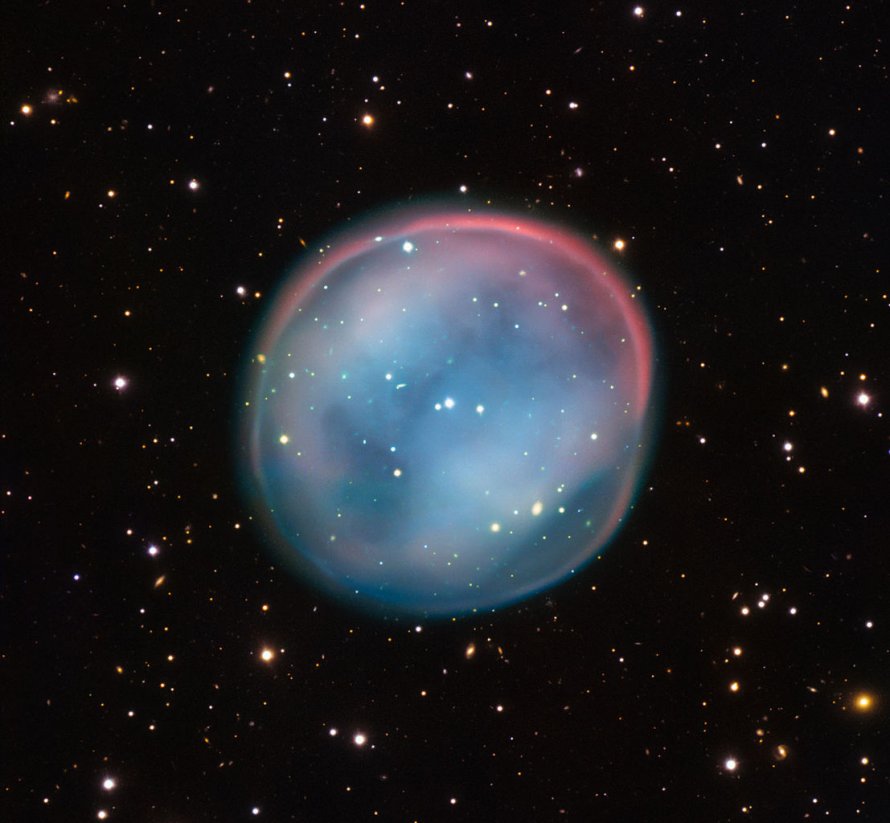M97 (NGC 3587) - Owl Nebula
Messier 97 (NGC 3587), also known as the Owl Nebula, is a planetary nebula located in the constellation Ursa Major, in the Orion Arm of the Milky Way Galaxy in the Local Group of galaxies. M97 is 2500 light years away from Earth.
M97 is best viewed during late spring, is magnitude 10, and can be viewed with small telescope. M97 is 3.4' x 3.3' in apparent size. For reference, the full moon is 30'.
Observing difficulty: Intermediate
- Name:
- Owl Nebula
- Type:
- planetary nebula
- Constellation:
- Ursa Major
- NGC or IC:
- NGC 3587
- Magnitude:
- 10
- Viewing:
- small telescope
- Size:
- 3.4' x 3.3'
- Distance (light years):
- 2500 LY
- RA:
- 11h 14.8m
- Dec:
- 55 1'
- Season:
- late spring
- Milky Way location:
- Orion Arm
- Galaxy group:
- Local Group
- Messier Marathon #:
- 36
* The naked eye can see up to magnitude ~7-8 objects under ideal dark sky conditions.
Exploring the Owl Nebula
Messier 97 (M97), commonly known as the Owl Nebula, is a planetary nebula located in the Ursa Major constellation. This captivating celestial object was first discovered by French astronomer Pierre M?chain in 1781 and later added to Charles Messier's catalog. The nebula's curious resemblance to an owl's face, with two large circular features akin to eyes, has given it its popular name.
Characteristics of Messier 97
The Owl Nebula is an example of a planetary nebula, a type of emission nebula consisting of an expanding, glowing shell of ionized gas ejected from aging red giant stars late in their lives. Its round appearance and the distinctive darker regions, which give the impression of owl-like eyes, make it one of the most recognizable nebulae in the sky.
Messier 97 is approximately 8,000 years old and spans about 0.91 light-years or 3 light-months across. Its spherical shell consists of gas shed by the dying star at its center, which has now evolved into a white dwarf.
Magnitude and Distance
Located about 2,030 light-years away from Earth, Messier 97 has an apparent magnitude of approximately 9.9, making it a relatively faint object in the night sky. The central star of the nebula has a much fainter magnitude of about 14, which typically requires a larger telescope to observe directly.
Finding and Observing Messier 97
The Owl Nebula is found within the constellation Ursa Major, which is well known for its prominent asterism, the Big Dipper. The nebula is located close to the bottom of the bowl of the Big Dipper, roughly 2.5 degrees southeast of the star Beta Ursae Majoris, also known as Merak.
Due to its relatively faint magnitude, M97 is not visible to the naked eye. Still, it can be observed through a small telescope or binoculars under optimal dark-sky conditions. With a larger telescope, observers can start to make out the nebula's round shape and possibly the owl-like "eyes" that give the nebula its name.
M97, with its intriguing morphology and the fascinating physical processes behind its formation, is a fascinating object for both amateur astronomers and professional scientists. Its observation provides a glimpse into the future of our own Sun, which is expected to shed its outer layers and form a planetary nebula in about 5 billion years.



